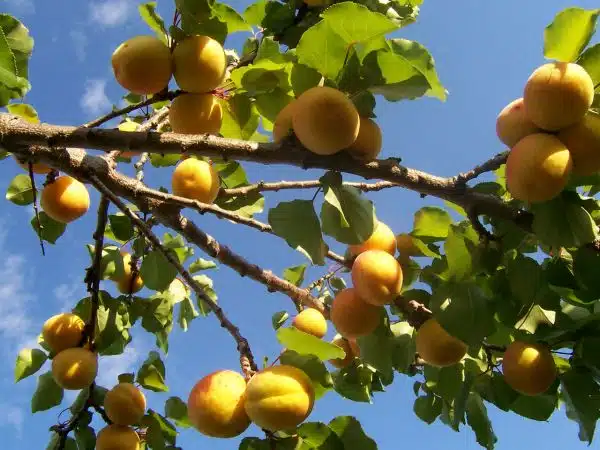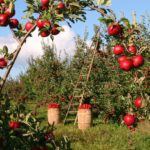Prunus armeniaca, commonly known as the apricot tree, is a small to medium-sized fruit tree that belongs to the Rosaceae family. It is native to Central Asia and has been cultivated for thousands of years for its delicious fruit. Apricots are highly nutritious and rich in vitamins A and C, fiber, and antioxidants. They are also a great source of potassium, which helps regulate blood pressure and maintain healthy heart function.
In this article, we will provide you with a comprehensive guide on how to care for and grow apricot trees successfully. We will cover all aspects of apricot tree cultivation, including soil preparation, planting techniques, pruning methods, pest and disease control measures, fertilization practices, and harvesting tips. Whether you are an experienced gardener or a novice looking to start your own orchard, this guide will help you achieve bountiful harvests of juicy and flavorful apricots that will satisfy your taste buds while providing numerous health benefits!
The History And Origin Of Apricot Trees
The apricot tree, also known as Prunus armeniaca, is a fruit-bearing tree originating from China. It belongs to the same family as peaches, plums, and cherries. Apricot trees are widely cultivated globally for their juicy fruits and ornamental purposes. They are known to have historical significance in many cultures.
The origins of the apricot tree can be traced back to around 3000 BC in China’s northern regions. The fruit was first mentioned in Chinese literature during the Zhou dynasty (1046-256 BC). From there, it spread along the Silk Road to Central Asia and Europe. The apricot tree became popular during the Roman Empire when it was introduced by Alexander the Great.
Apricots hold cultural symbolism in various regions worldwide. In Armenia, apricots symbolize fertility and good luck. In India, they are believed to have medicinal properties that can cure ailments such as constipation and anemia. In Europe, apricots represent summer and sunshine. Folklore depicts that a ripe apricot’s scent can ward off evil spirits. Understanding the history and cultural significance of this fruit is essential for successful cultivation and appreciation of its beauty and taste.
Transitioning into understanding the anatomy of apricot trees is crucial for proper care and maintenance of these trees. By learning about their structure, gardeners can make informed decisions on pruning techniques, pest control strategies, and fertilization practices to ensure optimal growth conditions for their beloved orchards or home gardens.
Understanding The Anatomy Of Apricot Trees
Apricot trees have a rich history and fascinating origin story, dating back to ancient China over 3,000 years ago. These trees were brought to the west by explorers and traders along the Silk Road in the Middle Ages. Today, apricot trees are widely cultivated across the globe, from Europe to America and beyond.
Understanding the anatomy of apricot trees is crucial for their proper care and maintenance. These deciduous trees typically grow up to 20-30 feet tall with a spread of 15-20 feet. Apricot tree growth patterns vary depending on the variety – some are more upright while others have a spreading habit. As with all fruit trees, it’s important to prune apricot trees regularly to promote healthy growth and maximum fruit production.
When it comes to apricot tree pruning techniques, there are several key considerations. First, remove any dead or diseased wood as soon as possible to prevent further damage. Second, thin out crowded branches to improve air circulation and sunlight penetration. Finally, shape the tree by selectively removing branches that cross or rub against each other. By following these simple steps, you can ensure that your apricot tree remains healthy and productive for years to come.
Next up: choosing the right varieties for your climate. It’s important to select a variety of apricot tree that is well-suited for your particular climate zone in order to maximize fruit production and overall health. Keep reading for our expert tips on how to choose the perfect apricot tree for your garden or orchard!
Choosing The Right Varieties For Your Climate
When selecting an apricot variety to grow in your garden, climate should be among the top considerations. Apricot varieties can be divided into three general classes: cold hardy, heat tolerant and intermediate. Cold hardy varieties, such as ‘Sunglo’, are better suited for cooler climates, while heat tolerant varieties like ‘Goldrich’ are more suitable for warmer climates. Intermediate varieties, like ‘Tilton’, are adapted to a wider range of climates.
Climate Considerations
As a horticultural expert, I understand the importance of considering climate when choosing the right varieties for your apricot tree. Microclimates play a significant role in the success of your tree’s growth and fruit production. For instance, if you live in an area with hot summers and mild winters, you should select apricot trees that can withstand high temperatures and low chilling hours. On the other hand, if you live in a cooler region with long winters, it is best to choose varieties that can tolerate cold temperatures and require more chilling hours.
Seasonal variations also affect the growth and development of apricot trees. During spring, apricot trees produce beautiful blossoms that later turn into fruits. However, early or late frosts can damage or kill these flowers, leading to poor fruit production. Therefore, it is crucial to select varieties that bloom later in areas prone to late frost or earlier in regions with early-spring warming trends. Additionally, warmer winters may cause early blooming and put your apricot tree at risk of frost damage.
In conclusion, choosing the right variety for your climate is vital for growing healthy and productive apricot trees. Consider factors such as microclimates and seasonal variations before making your selection. With proper care and attention to your tree’s needs, you can enjoy delicious apricots year after year.
Types Of Apricots
After considering the climate and seasonal variations, the next step in choosing the right apricot tree is to identify the different types of apricot trees available. There are several varieties of apricots, each with unique characteristics and best uses. Some of these include the Chinese, Moorpark, and Goldcot apricots.
The Chinese apricot tree is a hardy variety that can withstand temperatures as low as minus 30 degrees Fahrenheit. It produces small fruits that are sweet and tangy in flavor, making them ideal for drying or preserving. The Moorpark apricot tree is another popular variety that produces large, juicy fruits with a rich flavor. This variety requires a long growing season and plenty of sunshine to thrive.
Lastly, the Goldcot apricot tree is a hybrid variety that combines the best characteristics of both Chinese and Moorpark varieties. This type of apricot tree produces medium-sized fruits with an excellent balance of sweetness and tartness. It also requires less chilling hours compared to other varieties, making it ideal for areas with mild winters.
When selecting an apricot variety for your climate, it is essential to consider factors such as fruit size, flavor profile, chilling requirements, and disease resistance. By identifying these characteristics and understanding your environment’s needs, you can choose the right apricot tree for your garden or orchard.
Soil Preparation For Apricot Trees
Proper soil preparation is paramount for the successful cultivation of apricot trees. As a horticulturist, I suggest starting with a suitable site that receives adequate sunlight throughout the day. The soil must be well-draining and have good water retention capacity to ensure optimal growth. Land that is too compacted or heavy in texture would not suffice as it restricts root development and water penetration.
One way to prepare your soil is through composting. Composting benefits your soil by improving its structure and fertility, making it more conducive for plant growth. It involves decomposing organic matter such as leaves, grass clippings, and kitchen scraps into nutrient-rich compost that enriches your garden bed. You can either purchase compost from a reliable supplier or make your own using a compost bin at home.
Apricot trees have specific nutrient requirements that must be met for them to thrive. Before planting, test your soil’s pH level to determine its acidity or alkalinity. Apricots prefer slightly acidic soil with a pH range of 6.0-7.0; however, they can grow in neutral to slightly alkaline soils as well. If your soil is too acidic, you can add lime to raise the pH level gradually over time until it reaches the desired range. Incorporate organic fertilizers like bone meal or fish emulsion into the planting hole to provide essential nutrients required for healthy apricot tree growth.
Adequate soil preparation sets the foundation for optimal apricot tree growth and fruit production. In the subsequent section about planting techniques for optimal growth, we will explore how to plant your apricot tree correctly to give it the best chance of success in its new environment.
Planting Techniques For Optimal Growth
Soil preparation is essential for optimal growth of apricot trees (Prunus armeniaca). It should be amended with organic matter to improve its water-holding capacity, drainage, and aeration. Planting depth should take into account the root system of the apricot tree, making sure that the roots are placed below the soil surface. Apricot trees should be planted slightly higher than the surrounding soil to ensure proper drainage.
Soil Preparation
To ensure optimal growth of an apricot tree (Prunus armeniaca), proper soil preparation is essential. Before planting, it is important to conduct a pH testing of the soil to determine its acidity or alkalinity level. Apricot trees typically thrive in soil with a pH level between 6.0 and 7.5. If the pH level falls below this range, it may be necessary to add lime to raise the acidity level, while adding sulfur can help lower it.
In addition to pH testing, organic amendments can also be added to enhance the quality of the soil for apricot tree growth. These include compost, aged manure, and other organic matter that can improve soil texture and drainage while also providing necessary nutrients. It is recommended to add these amendments at least two weeks before planting so that they have time to break down and integrate into the soil.
By taking these steps for proper soil preparation, an apricot tree can have a strong start towards healthy growth and bountiful harvests. Ensuring optimal conditions for planting sets the foundation for long-term success and enjoyment of this beloved fruit tree.
Planting Depth
Proper soil preparation is just one step towards ensuring optimal growth of apricot trees. Another crucial factor to consider is the planting depth. Planting apricot trees too deep or too shallow can lead to poor growth and a reduced yield.
When planting an apricot tree, it is important to ensure that the graft union (the point where the rootstock and scion are joined) is planted above ground level. This helps prevent the rootstock from growing and taking over the tree, which can negatively affect fruit production. Proper spacing between trees is also important for optimal growth, with a recommended distance of at least 15 feet between each apricot tree.
After planting, mulching techniques can also be used to promote healthy growth. A layer of organic material such as straw or wood chips around the base of the tree can help retain moisture in the soil while also suppressing weed growth. It is important not to mound mulch against the trunk of the tree, as this can create a favorable environment for pests and diseases.
By paying attention to proper planting depth and utilizing mulching techniques, gardeners can set their apricot trees up for success in their new home. With these steps in mind, a bountiful harvest of delicious apricots can be achieved for years to come.
Irrigation And Watering Needs Of Apricot Trees
Apricot trees require moderate watering, particularly during their active growth period. Drip irrigation is a good option for apricot trees as it delivers water directly to the roots, reducing water waste and improving soil moisture content. During summer, mature trees require approximately 2-3 gallons of water per week, while young ones need about half a gallon of water per day.
It is important to monitor soil moisture levels regularly to determine when watering is necessary. Testing soil by inserting a finger into the ground or using a soil moisture meter can help you identify dry spots so that you can adjust your irrigation accordingly. Properly watering apricot trees helps prevent leaf wilt and fruit splitting, which are common problems resulting from inadequate or excessive watering.
To ensure that your apricot tree thrives, follow these four tips:
- Water at least once or twice weekly during summer months
- Avoid over-watering as it may cause root rot
- Maintain consistent moisture levels in the soil
- Use drip irrigation to reduce water waste and improve irrigation efficiency
As you monitor your apricot tree’s irrigation needs, remember that managing its water is just one part of maintaining its health and promoting abundant fruit production. In the next section, we will explore fertilization practices for healthy growth that complement proper irrigation techniques.
Fertilization Practices For Healthy Growth
- Apricot trees should be fertilized yearly in the late winter or spring before bud break with a balanced fertilizer that is specifically formulated for fruit trees.
- Different types of fertilizer should also be used throughout the growing season to promote healthy growth, such as nitrogen-based fertilizers, phosphorus-based fertilizers, and potassium-based fertilizers.
- Micro-nutrient fertilizers should also be used in the late summer to ensure that the tree is receiving the necessary nutrients for optimal health and growth.
- Fertilization frequency should be adjusted based on the soil fertility and the age of the tree; for example, young trees should be fertilized more often than mature trees.
Fertilizer Types
When it comes to fertilizing apricot trees, there are two main types of fertilizers that gardeners can choose from: organic and synthetic. Organic fertilizers are derived from natural sources such as animal manure, bone meal, and compost. They release nutrients slowly over time and improve soil health by adding beneficial microorganisms. Synthetic fertilizers, on the other hand, are made from chemical compounds and provide a quick boost of nutrients to the tree.
Organic fertilizers are often preferred by gardeners who prioritize sustainability and want to avoid harsh chemicals in their gardens. They offer several benefits beyond just providing nutrients to the tree. For example, they improve soil structure by increasing soil porosity and water-holding capacity. Additionally, they promote healthy microbial activity in the soil which helps break down organic matter into more plant-available forms.
Synthetic fertilizers are convenient because they provide a quick boost of nutrients to the tree when needed. They often come in a variety of formulations designed for specific stages of growth or nutrient deficiencies. However, they do have some downsides including the potential for leaching into groundwater or causing salt buildup in the soil over time. As with any chemical application in the garden, it’s important to follow instructions carefully and use them sparingly.
In conclusion, both organic and synthetic fertilizers have their pros and cons when it comes to feeding an apricot tree. Ultimately, choosing which type to use will depend on individual gardening goals and philosophies. A balanced approach that incorporates both types may be the best course of action for optimal tree health and fruit production while also taking care of our environment.
Frequency Of Fertilization
Fertilization is a crucial aspect of apricot tree care. To ensure healthy growth and fruit production, gardeners need to determine the best fertilization practices for their trees. One important aspect to consider is the frequency of fertilization. How often should gardeners fertilize their apricot trees?
The answer to this question depends on several factors, including the age and size of the tree, soil type and quality, and climate. Generally, young trees require more frequent fertilization than mature ones because they are still establishing their root systems. Gardeners can apply fertilizer every 4-6 weeks during the growing season (spring through fall) for young trees. Mature apricot trees may only need one or two applications per year.
It’s essential to monitor signs of over-fertilization in apricot trees as it can cause harm than good to your tree. Signs include yellowing leaves, stunted growth, leaf burn, and reduced fruit quality or quantity. To prevent over-fertilizing apricot trees, it’s crucial to follow recommended application rates carefully and avoid applying fertilizer too close to the trunk or in concentrated areas. By maintaining proper frequency and dosage of fertilizer application, gardeners can help ensure healthy growth and fruit production from their apricot trees for years to come.
Pruning Methods For Maximum Yield
To make the most of your apricot tree’s yield, it is essential to use proper pruning techniques. There are two main times to prune your apricot tree: summer and winter. Summer pruning is recommended for young apricot trees, while mature trees respond best to winter pruning.
Summer pruning is done in June or July and involves removing any new growth that has sprouted from the trunk or main branches. This technique encourages stronger growth in the remaining branches and stimulates fruit production. For young apricot trees, it is important to train them into a strong shape by removing any branches that grow too low or too high on the trunk. This helps establish a solid structure for future growth.
Winter pruning, on the other hand, should be done when your apricot tree is dormant between December and February. This type of pruning focuses on removing dead or diseased wood as well as thinning out any overcrowded branches to allow more sunlight into the center of the tree. By doing so, you encourage healthy growth and increase yields in future years.
Pruning is a vital part of maintaining a healthy and productive apricot tree. By using these techniques for young versus mature trees, you can ensure that your apricots are both delicious and abundant. In the next section, we will discuss common pests and diseases of apricot trees, which can also impact yield if left untreated.
Common Pests And Diseases Of Apricot Trees
The beauty of an apricot tree in full bloom is unparalleled, but its susceptibility to pests and diseases can be a cause for concern. Identifying symptoms early on can help mitigate any damage caused by these unwanted visitors. One common pest that affects apricot trees are aphids, which feed on the sap of leaves and stems, causing them to wilt and curl. Another pest to watch out for is the peach twig borer, which damages the fruit and leaves by burrowing into the tree.
When it comes to treating pests and diseases in apricot trees, there are several options available depending on the severity of the problem. For aphids, spraying with insecticidal soap or neem oil can be effective. For more severe infestations, a systemic insecticide may be necessary. As for peach twig borers, pruning affected branches and applying a pesticide containing spinosad can control their population.
Identifying symptoms early on is crucial in treating any problems that arise with your apricot tree. While treatment options exist for most pests and diseases, prevention is always better than cure. In the subsequent section, we will discuss preventative measures for pest and disease control that will keep your apricot tree healthy and thriving year after year.
Preventative Measures For Pest And Disease Control
To maintain the health of apricot trees, it is essential to implement preventative measures for pest and disease control. Integrated pest management (IPM) is a sustainable approach that combines different methods to manage pests and diseases effectively. This method entails identifying the problem, monitoring the situation, and using natural remedies when possible. For instance, introducing predatory insects such as ladybugs or lacewings can help control aphids.
Another effective way to control pests is through regular pruning. Removing dead or diseased wood can help reduce the chances of pests attacking the tree. Additionally, practicing good hygiene by cleaning up fallen leaves and fruit can prevent diseases from taking hold in your apricot tree. In cases where chemical treatments are necessary, only use them as a last resort and under expert guidance.
In conclusion, preventing pest and disease infestation in apricot trees requires attention to detail and consistent care. By implementing IPM methods like natural remedies, regular pruning, and good hygiene practices, you can keep your apricot tree healthy without relying on chemical treatments. In the next section, we will discuss how to know when your apricots are ready for harvesting and how best to store them to ensure they stay fresh for longer periods.
Harvesting And Storing Apricots
Once you have determined that your apricots are ready for harvest, it’s important to handle them with care. The fruit should be picked gently, using a twisting motion to detach it from the tree. Be sure to leave the stem intact, as this will help prevent bruising. It’s best to harvest apricots early in the morning or late in the evening when temperatures are cooler, as this will help preserve their quality.
When it comes to storing apricots, there are a few best practices to keep in mind. First and foremost, they should be stored at room temperature until they are fully ripe. Once ripe, they can be stored in the refrigerator for up to three days. If you have more than you can eat fresh, apricots freeze well and can be used later in recipes such as jams, pies, and smoothies.
If you’re looking for ways to use up your apricot harvest, there are plenty of delicious recipes out there! Apricot jam is a classic option that allows you to enjoy the fruit’s sweet flavor long after the season is over. You could also try making an apricot tart or adding diced apricots to your favorite salad recipe. With so many possibilities, harvesting apricots is just the beginning of a culinary adventure!
As you explore different ways of cooking and preserving apricots, keep in mind that their delicate flavor can easily be overwhelmed by other ingredients. For best results, try pairing them with complementary flavors such as almonds or honey. By experimenting with different techniques and recipes, you’re sure to find plenty of new ways to enjoy this delicious fruit!
Cooking And Preserving Apricots
It is estimated that over 90% of apricots produced worldwide are used for processing, with the majority being made into dried apricots or apricot jam. This makes sense as apricots are a seasonal fruit that ripen quickly and need to be preserved to last longer. Cooking and preserving apricots is a great way to enjoy their sweet, tangy flavor all year round.
One popular method of preserving apricots is by making jam. Apricot jam is easy to make and requires only a few ingredients. Simply combine fresh, pitted apricots with sugar and lemon juice in a pot, bring to a boil, then simmer until the mixture thickens. The resulting jam can be canned for long-term storage or stored in the fridge for shorter periods of time.
Dried apricots are another delicious way to preserve this fruit. To dry them at home, slice fresh apricots in half and remove the pit. Place them on a baking sheet lined with parchment paper and bake at a low temperature for several hours until they are dry but still slightly pliable. Dried apricots can be eaten as a snack or added to baked goods like muffins or granola bars.
Preserving your own apricots not only allows you to enjoy them year-round but also helps reduce food waste by using up excess fruit before it spoils. In the next section, we will discuss how you can use an apricot tree in your landscaping to not only beautify your space but also provide you with delicious fruit for preserving.
Using Apricot Trees For Landscaping
Apricot trees are not only prized for their delicious fruit but also for their ornamental uses in landscape design. They can be utilized to create a stunning focal point or as part of an edible garden. With proper care and maintenance, apricot trees can add beauty and functionality to any outdoor space.
When using apricot trees for landscaping, it is important to consider their growth habits and size. Most varieties of apricot tree can reach heights of 12-15 feet with a spread of up to 10-12 feet. Therefore, they require ample space to grow and thrive. It is also important to select a location that receives full sun exposure throughout the day and has well-draining soil.
In addition to their aesthetic value, apricot trees can also serve practical purposes in the landscape. They can provide shade during hot summer months, attract beneficial pollinators such as bees and butterflies, and offer a source of fresh fruit for homeowners to enjoy. When considering ornamental uses for apricot trees in landscape design, it is important to keep these factors in mind.
- Use dwarf varieties for smaller landscapes
- Plant near other fruit trees or vegetables for an edible garden
- Prune regularly to maintain shape and prevent disease
- Consider using as a focal point in a garden bed or border
- Utilize underplanting with low-growing shrubs or perennials
Transition into the subsequent section: While using apricot trees for landscaping can add beauty and function to an outdoor space, there are some common misconceptions about their care and growing requirements that need to be addressed.
Common Misconceptions About Apricot Trees
As the famous adage goes, “Don’t judge a book by its cover.” Similarly, one should not judge an apricot tree by its delicate appearance. Many people have misconceptions about this fruit tree, which can lead to improper care and maintenance. In this section, we will explore some of the most common misconceptions about apricot trees.
One of the biggest misconceptions is that these trees are high-maintenance and require a lot of attention. However, with proper care and pruning techniques, apricot trees can be relatively easy to maintain. Regular pruning is essential to prevent overcrowding and ensure adequate sunlight penetration for fruit production. Additionally, it is important to note that while apricot trees are susceptible to certain pests, they are generally hardy plants that can withstand harsh weather conditions.
Another misconception is that apricot trees require a lot of water. While it is true that these trees need regular watering during their early growth stages, established apricot trees do not require as much water as one might think. Overwatering can actually harm the tree and increase the risk of root rot or other diseases. It is best to water deeply but infrequently, allowing the soil to dry out slightly between watering sessions.
In summary, there are several common misconceptions about caring for apricot trees that gardeners should be aware of. With proper pruning techniques and appropriate watering practices, these fruit trees can thrive in a variety of climates and conditions. However, it is also important to stay vigilant against potential pest problems such as aphids or mites. In the next section, we will discuss how to troubleshoot some common issues that may arise when caring for your apricot tree.
Troubleshooting Common Apricot Tree Problems
Identifying symptoms of common apricot tree problems can help gardeners take steps to prevent or treat issues before they become more serious. One common problem is brown rot, which appears as brown spots on the fruit and can quickly spread to other areas of the tree. Another issue is bacterial canker, which causes swollen, discolored bark that may ooze sap or gum. Leaf curl is another symptom to watch for, as it can indicate a fungal infection that causes leaves to curl and distort.
If you notice any of these symptoms on your apricot tree, it’s important to take action right away. Integrated pest management techniques can be effective for preventing and treating many common problems. This approach involves using a combination of cultural practices (such as proper pruning and sanitation), biological controls (such as introducing beneficial insects), and chemical treatments (such as fungicides) as needed.
Preventing common apricot tree problems is key to keeping your tree healthy and productive. Some effective preventative measures include planting disease-resistant varieties, providing proper irrigation and drainage, avoiding over-fertilization, and practicing good sanitation by removing fallen fruit and debris from around the base of the tree. By taking these steps, you can enjoy a bountiful harvest of delicious apricots year after year without having to worry about common problems that can threaten the health of your tree.
Conclusion
The apricot tree, Prunus armeniaca, is a delightful addition to any garden or orchard. Native to China and Central Asia, this fruit tree has a long history of cultivation and appreciation. Understanding the anatomy of the apricot tree is crucial for proper care and maintenance. Soil preparation before planting is essential for optimal growth, as is selecting the right varieties that are suitable for your climate.
Cooking with apricots can be a wonderful experience, as their sweet-tart flavor lends itself well to both sweet and savory dishes. Preserving apricots for use throughout the year is also an option. In addition to their culinary uses, apricot trees can also be used in landscaping to add beauty and shade to your outdoor space.
Despite its many benefits, there are common misconceptions about apricot trees that need to be addressed. Troubleshooting common problems such as pests and diseases will help ensure a healthy crop each year.
In conclusion, growing an apricot tree requires careful attention to detail but rewards with delicious fruit and a stunning addition to your landscape. With proper care and maintenance, this ancient fruit tree remains a cherished part of our horticultural heritage. As we tend our trees, we become stewards of this living symbol of nature’s bounty – one that has stood witness to human history since time immemorial.
Image Credits
- “Apricot tree” by Fir0002 (featured)





























